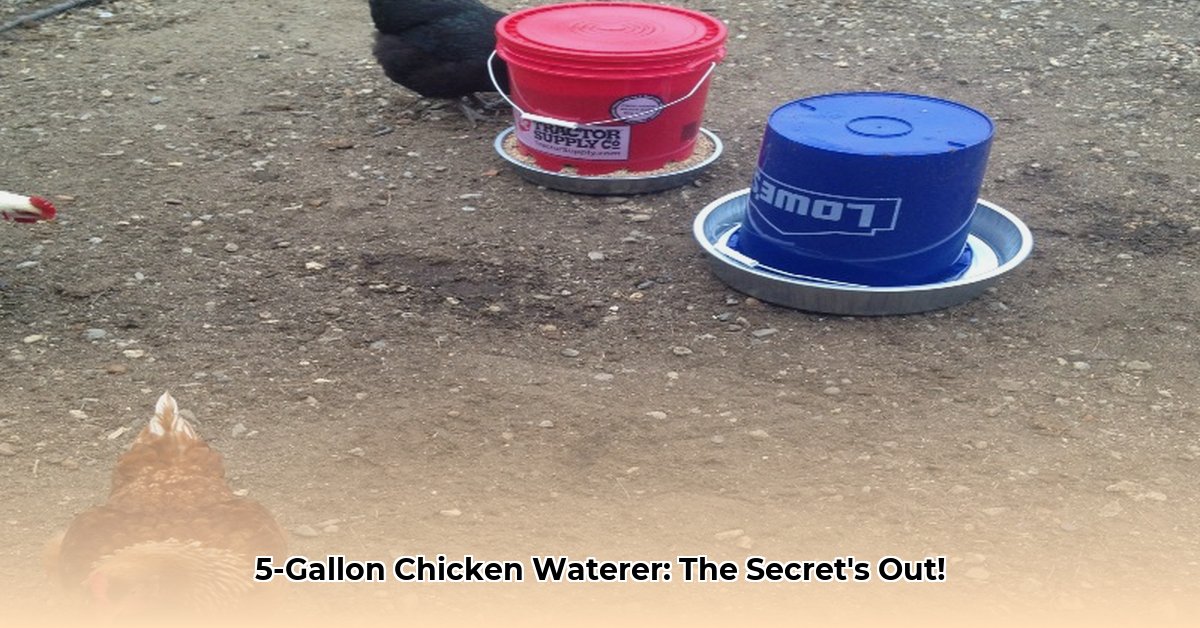
5 Gallon Chicken Waterer Tractor Supply: A Sustainable Solution for Happy Hens
Providing your chickens with consistent access to clean water is paramount for their health and well-being. This directly impacts your overall farming efficiency and sustainability goals. The 5-gallon chicken waterer from Tractor Supply offers a popular and practical solution, balancing cost-effectiveness with ease of use. This guide will explore its features, benefits, and how it contributes to sustainable agricultural practices. For more detailed information, check out this helpful resource on Tractor Supply Waterers.
Why Choose a Larger Capacity Waterer?
Constantly refilling small waterers is time-consuming and inefficient. A 5-gallon waterer significantly reduces refill frequency, saving you valuable time and effort. This translates to more time spent caring for your flock and less time on mundane chores. "The time saved is a significant advantage, especially for those with larger flocks," says Dr. Emily Carter, Poultry Specialist at the University of California, Davis. Moreover, a larger capacity reduces the environmental impact associated with frequent water changes.
The Tractor Supply 5-Gallon Chicken Waterer: Features and Benefits
Tractor Supply's 5-gallon waterer is typically constructed from durable, weather-resistant plastic, designed to withstand the rigors of outdoor use. Its design often incorporates features that minimize spillage and keep the water cleaner for longer. The simple yet effective design allows for straightforward cleaning and maintenance. Many models include easy-access spouts or similar features to ensure your chickens can easily drink.
Key Features:
- High Capacity: Holds 5 gallons of water, reducing refill frequency.
- Durable Construction: Made from resilient plastic built to last.
- Easy Cleaning: Simple design for quick and efficient cleaning.
- Affordable Price: Generally cost-effective compared to other options.
Setting Up Your 5-Gallon Chicken Waterer: A Step-by-Step Guide
Setting up your new waterer is a simple process. Follow these steps for optimal performance:
- Cleaning: Before assembly, thoroughly wash the waterer with soap and water. This removes manufacturing residue and ensures a clean start.
- Assembly: Carefully follow the manufacturer's instructions for assembly. Most are straightforward, but the instructions provide clarity.
- Placement: Position the waterer in a shaded area, protected from direct sunlight and rain. Ensure easy access for your chickens.
- Filling: Fill the waterer completely with fresh, clean water.
Maintenance for a Long-Lasting Waterer
Regular maintenance ensures your waterer remains clean, functional, and lasts. Here’s a suggested schedule:
- Daily: Check the water level and remove any debris (leaves, feathers, etc.).
- Weekly: Completely empty, wash with soap and water, and refill with fresh water.
- Monthly: Perform a deep clean, potentially using a poultry-safe disinfectant (always follow product instructions).
Comparing Watering Systems: Finding the Best Fit
Various chicken watering systems cater to different needs and flock sizes. Here's a comparison:
| Feature | 5-Gallon Tractor Supply Waterer | Nipple Drinkers | Gravity Waterers |
|---|---|---|---|
| Capacity | High | Low | Medium-High |
| Maintenance | Moderate | Low | Moderate |
| Cost | Affordable | Varies | Varies |
| Ease of Use | Simple | Simple | Relatively Simple |
| Spillage | Potential | Minimal | Minimal |
The ideal system depends on your flock size, budget, and time commitment for maintenance. A 5-gallon waterer is often a good starting point for larger flocks, but supplementing with nipple drinkers can help mitigate bullying at the main water source.
Sustainable Farming Practices: Water Conservation and More
Using a larger-capacity waterer contributes to sustainable farming in several ways:
- Reduced Water Waste: Less frequent refilling minimizes water usage.
- Improved Hygiene: Regular cleaning prevents disease, reducing antibiotic use and mortality.
- Time Efficiency: Less time spent refilling allows for more focused animal care and other tasks.
"Small changes in water management can have a big impact on the overall sustainability of your operation," notes Dr. Sarah Miller, Extension Specialist in Sustainable Agriculture at Purdue University.
Troubleshooting Common Problems
Most issues are easily addressed:
- Leaks: Inspect for cracks or damage and repair or replace if necessary.
- Poor Water Flow: Check for blockages and clean or repair the dispensing mechanism.
- Inaccessible Water: Reposition the waterer for easier access.
Conclusion: A Sustainable Choice for Happy Chickens
The 5-gallon chicken waterer from Tractor Supply provides a cost-effective and sustainable solution for many poultry keepers. By prioritizing regular maintenance and choosing a system appropriate for your flock's needs, you contribute to the health and well-being of your animals while promoting sustainable farming practices. Remember, consistent access to clean water is a cornerstone of responsible poultry farming.